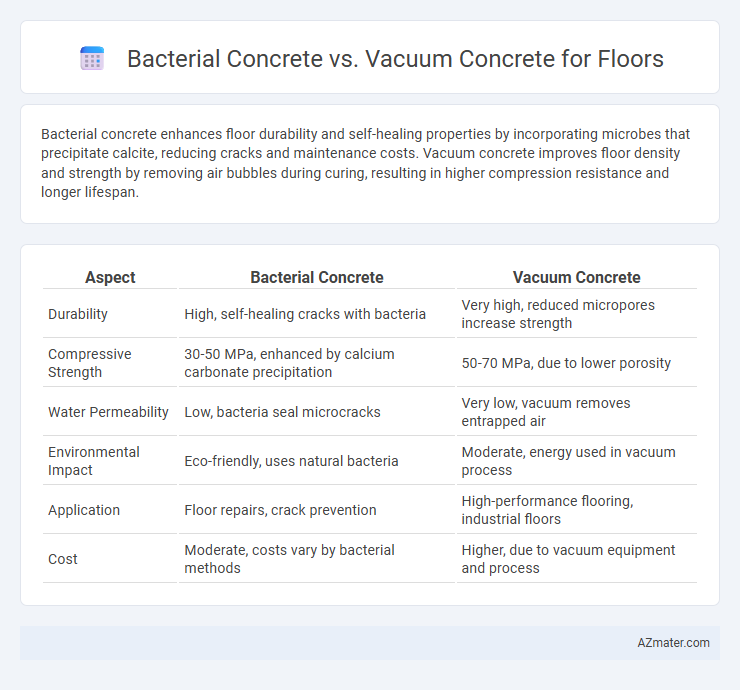Bacterial concrete enhances floor durability and self-healing properties by incorporating microbes that precipitate calcite, reducing cracks and maintenance costs. Vacuum concrete improves floor density and strength by removing air bubbles during curing, resulting in higher compression resistance and longer lifespan.
Table of Comparison
| Aspect | Bacterial Concrete | Vacuum Concrete |
|---|---|---|
| Durability | High, self-healing cracks with bacteria | Very high, reduced micropores increase strength |
| Compressive Strength | 30-50 MPa, enhanced by calcium carbonate precipitation | 50-70 MPa, due to lower porosity |
| Water Permeability | Low, bacteria seal microcracks | Very low, vacuum removes entrapped air |
| Environmental Impact | Eco-friendly, uses natural bacteria | Moderate, energy used in vacuum process |
| Application | Floor repairs, crack prevention | High-performance flooring, industrial floors |
| Cost | Moderate, costs vary by bacterial methods | Higher, due to vacuum equipment and process |
Introduction to Innovative Concrete Technologies
Bacterial concrete enhances floor durability by utilizing microorganisms that produce calcite, effectively healing cracks and increasing resistance to environmental stress. Vacuum concrete improves floor density and strength through the removal of excess water using vacuum dewatering techniques, resulting in faster curing and superior load-bearing capacity. Both innovative concrete technologies address durability and longevity challenges in construction, optimizing performance for floor applications.
Overview of Bacterial Concrete
Bacterial concrete incorporates specific microorganisms that precipitate calcium carbonate, enhancing self-healing properties and increasing durability by sealing cracks and preventing water ingress. This eco-friendly technology improves the lifespan of flooring by reducing maintenance costs and enhancing structural integrity compared to conventional concretes. The integration of bacteria into the concrete matrix represents a sustainable innovation in construction materials for long-lasting, resilient floor surfaces.
Understanding Vacuum Concrete
Vacuum concrete enhances floor durability by utilizing a vacuum de-aeration process to remove excess water and air, resulting in higher compressive strength and reduced permeability compared to traditional mixes. Unlike bacterial concrete, which relies on microbial activity to self-heal cracks, vacuum concrete offers immediate mechanical improvements ideal for floor applications requiring fast curing and load-bearing capacity. This method ensures a dense, uniform concrete matrix critical for industrial and commercial flooring durability and longevity.
Key Differences in Composition and Structure
Bacterial concrete incorporates microbial-induced calcium carbonate precipitation to enhance self-healing properties, using bacteria like Sporosarcina pasteurii embedded in the cement matrix to seal cracks and improve durability. Vacuum concrete is characterized by its removal of excess water through vacuum dewatering techniques, resulting in a denser, less porous structure with higher compressive strength and faster curing times. The key difference lies in bacterial concrete's bio-mediated mineralization improving crack resistance, whereas vacuum concrete achieves superior structural integrity through optimized moisture reduction and compaction.
Strength and Durability Comparison
Bacterial concrete enhances strength by inducing calcite precipitation, which improves crack resistance and self-healing properties, leading to superior durability compared to conventional concretes. Vacuum concrete exhibits increased density and reduced porosity through air removal, resulting in higher compressive strength and improved resistance to freeze-thaw cycles. In floor applications, bacterial concrete offers long-term durability by repairing micro-cracks autonomously, while vacuum concrete provides immediate mechanical strength and lower permeability, optimizing durability under heavy loads.
Floor Performance: Load Bearing and Crack Resistance
Bacterial concrete enhances floor performance by improving crack resistance through microbial-induced calcite precipitation, which fills micro-cracks and increases durability under load-bearing conditions. Vacuum concrete improves load-bearing capacity by reducing porosity and increasing density, resulting in stronger floors with greater compressive strength. When comparing floor performance, bacterial concrete offers superior crack self-healing properties while vacuum concrete provides enhanced structural integrity and load resistance.
Sustainability and Environmental Impact
Bacterial concrete incorporates microbial-induced calcium carbonate precipitation to self-heal cracks, extending the lifespan of floors and reducing the need for frequent repairs, which lowers material consumption and waste generation. Vacuum concrete utilizes a vacuum process to remove excess water, resulting in higher density, improved strength, and lower permeability, which enhances durability but involves higher energy consumption during manufacturing. Both technologies aim to improve sustainability by increasing durability, though bacterial concrete offers greater potential for reducing carbon footprint through bio-remediation, while vacuum concrete focuses on performance enhancement with a relatively higher environmental cost.
Cost Analysis for Flooring Applications
Bacterial concrete reduces long-term maintenance costs by self-healing micro-cracks, significantly extending floor durability compared to conventional vacu um concrete, which requires more frequent repairs and replacements. Initial material costs for bacterial concrete are higher due to specialized microbial additives, but overall lifecycle expenses tend to be lower through reduced repair frequency and enhanced structural integrity. Vacuum concrete flooring demands precise curing processes and equipment, increasing upfront installation expenses without comparable improvements in longevity or maintenance cost reduction.
Maintenance and Longevity Considerations
Bacterial concrete incorporates microorganisms that enhance self-healing properties, significantly reducing maintenance by automatically sealing cracks and preventing water infiltration, thereby extending floor longevity. Vacuum concrete, known for its dense microstructure achieved through vacuum dewatering, minimizes voids and enhances durability but may require more frequent inspections to address surface wear and minor damages. Both types offer improved lifespan compared to traditional concrete, with bacterial concrete providing superior maintenance savings due to its intrinsic crack repair capabilities.
Choosing the Right Concrete for Floor Construction
Bacterial concrete enhances floor durability by self-healing micro-cracks through microbial activity, reducing maintenance costs and increasing lifespan. Vacuum concrete offers superior density and strength by removing air bubbles during mixing, making it ideal for high-load and industrial flooring applications. Selecting the right concrete depends on factors like load requirements, environmental conditions, and desired longevity, with bacterial concrete suited for sustainable, crack-resistant floors and vacuum concrete preferred for maximum structural integrity.

Infographic: Bacterial concrete vs Vacuum concrete for Floor
 azmater.com
azmater.com